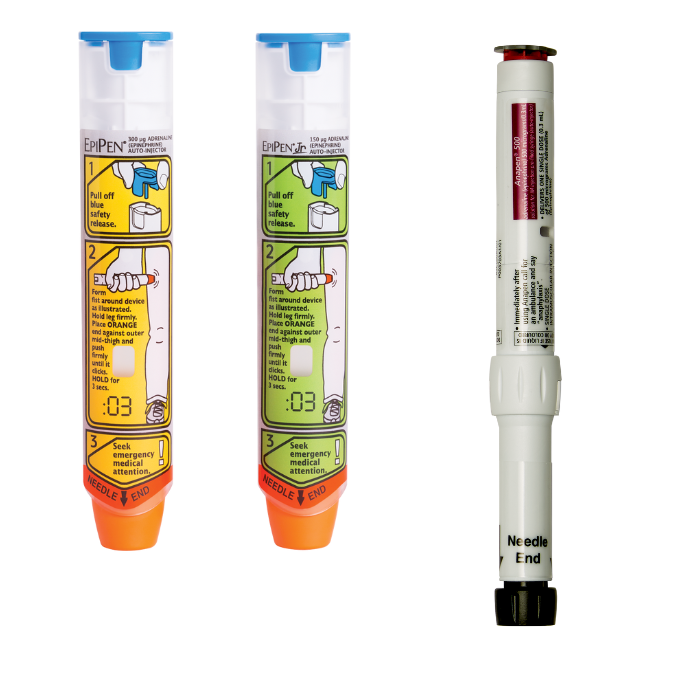On this page

If a school aged child is at risk of anaphylaxis and has been prescribed adrenaline (epinephrine) devices (Anapen® or EpiPen®), parents should provide at least one adrenaline device to school along with a copy of the ASCIA Action Plan for Anaphylaxis.
Where the prescribed adrenaline device is kept depends on the student’s age, level of understanding, travel arrangements and care outside of school.
The adrenaline device, ASCIA action plan and other medications should be kept together in a container or bag that is clearly labelled with the student’s first and last name. This is called the emergency medical kit. What is included in the emergency medical kit depends on the student’s needs but should at least contain the adrenaline device and ASCIA Action Plan for Anaphylaxis.
All schools must have a system in place that gets the medication to the student quickly once the signs of an allergic reaction appear.
Primary School

In primary school, an emergency medical kit should be kept in an easily accessible, central, unlocked location on the school grounds when the student is at school.
Young children should not have the emergency medical kit containing the adrenaline device on their person. Our reasons include (but are not limited to):
- Carrying a medical kit may make it harder for young children to play.
- Children playing with their adrenaline device or showing their friends and injecting themselves or their friend by accident
- Children playing with the device, setting it off and then putting it back in the emergency medical kit without telling anyone
- Children taking off their emergency medical kit and leaving it somewhere
- The risk of a device being broken from playground activity and falls
- The risk of increasing anxiety in a child who thinks their medication MUST be right next to them at all times.
Students’ carrying their own adrenaline device
There are some young students who may need to carry their emergency medical kit in their school bag. Reasons for this may include:
- Travelling to or from school by themselves (for example walking or taking a bus)
- Traveling to or from school in an assisted school travel program
- Attending Out of Hours School Care (OSHC) where families are unable to provide the OHSC with an adrenaline device (for example, one is already with school and other one is for home)
- Having another family member pick them up after school, for example grandparent, aunty or older sibling
- Families who live in separate homes
If a young student is required to carry their adrenaline device in their school bag, this should be discussed with school staff and included in the individualised anaphylaxis care plan. A copy of the ASCIA Action Plan for anaphylaxis should be kept with the adrenaline device.
In later primary years and if the child is showing signs that they have maturity and understanding, parents can think about having their child carry their adrenaline device and ASCIA action plan in their school bag. This may help the student prepare for high school where they often get themselves to and from school without parent drop off/pick up, move from class to class and sometimes have activities off campus.
Parents should discuss this with their child and the class teacher and include any changes in the individualised anaphylaxis care plan.
High (Secondary) School

In some high schools students carry their adrenaline device themselves throughout the day. This means they have it with them as they move from class to class. They may carry it in their school bag, laptop bag, pencil case or small teenage acceptable bag. It does not mean the adrenaline device has to be attached to their body at all times.
In other high schools, students never carry their own adrenaline devices except when travelling to and from school. In these schools, the adrenaline device is kept in a central location that is known by all students and staff.
What is important is that the student and staff (and other students) understand what to do in an emergency and where the adrenaline device is kept. There must be a procedure to ensure an adrenaline device is taken with the student any time they leave the school, for example to attend a sporting event.
A decision about where the adrenaline device is kept in high school and whether the student is to carry it on their person is site-specific and should be made when developing the student’s individualised anaphylaxis care plan. The student, and their parents/guardians should be involved making the decision.
The following issues should be considered:
- Parents and students should have a way to remember to take their adrenaline device to school and home again.
- How easy is it for the school to access the adrenaline device if it is kept with the student?
- Does the school have a general use adrenaline device in case the school cannot access the student’s prescribed device?
If the student is carrying their own adrenaline device throughout the day:
- A copy of the ASCIA Action Plan for anaphylaxis should be kept with the adrenaline device.
- People other than the student should know where the adrenaline device is kept, for example friends, classmates, teacher. It should be written in the individual anaphylaxis care plan where the adrenaline device is kept.
- Do not leave the adrenaline device in a locked locker.
- If kept in a school bag, have a way to identify the student’s bag easily, for example a unique colour/pattern or a bright coloured attachment.
- There should be a general use adrenaline device in a central location which can be used it the student’s own adrenaline device cannot be located quickly.
- The school must have a process for getting the emergency medication to the student quickly.
Remember:
- Even if a student is carrying their own adrenaline device, they may not be able to give it to themselves. They may not be thinking clearly or may be too sick because of the anaphylaxis.
- If a student gives themself their adrenaline device, they should get another student to immediately get help from a staff member.
- If they do not have the adrenaline device on them, they must alert a friend or a teacher so the medication can be brought to them.
It is important to work with your child’s school to decide whether your child should be carrying their own adrenaline device. Each child and school are different.
For more about where to keep adrenaline device click here.
